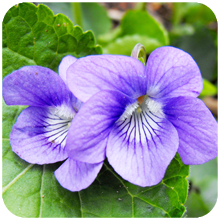
Herbaceous perennial plants with stems, aerial parts develop a long articulated rhizome approx. 3 cm long. In the absence of stems, size is modest. Also from the rhizomes, the plant developes roots, ensuring a vegetative propagation of the species. (2-15 cm). The leaves are long petiolate, based on these stems, forming triangular stipele. Foliage appears in two rows. Flowers on long petiole, zygomorph, fragrant, solitary, 5 violet petals, sometimes white or blue in color. The flower represents a straight or bent up spur. Fruit is a globular capsule, green or purple in color, which opens in 3 valves at maturity, releasing seeds which reach to the ground. The seeds are slightly elongated, with a smooth external surface, representing at one end a fleshy socket.
Chemical composition – Flowers containing essential oil consisting of unsaturated aliphatic aldehydes and alcohols including nonadienol and octodienol, anthocyanins, benzyl alcohol and unsaturated ketone (parmone), traces of eugenol; resins, sugars, violaquercetine (rutoside) violamine – a blue pigment, traces of salicylic acid, mucilage, minerals etc..
Properties – Expectorant, anti-inflammatory, healing, laxative, diforatic, diuretic, antiseptic, disinfectant, sedative, antirheumatic.
Recommendation – Gastrointestinal disorders, bronchitis, gout, rheumatic diseases, cough, inflammation of urinary and digestive tract, fever, angina.
This plant is incorporated in natural remedy COUGHEND Syrup.




